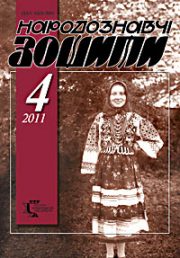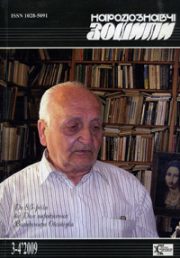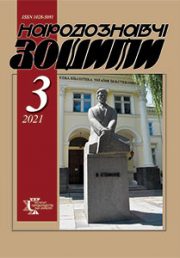The Ethnology Notebooks. 2024. № 4 (178), 799—809
UDK 398.87(477=161.2+5-15=1):[008:17.035.3]
DOI https://doi.org/10.15407/nz2024.04.799
NABOK Maryna
- ОRCID ID: https://orcid.org/0000-0001-9422-730X
- Candidate of Philology, Docent
- Department of language preparation of foreign citizens
- Sumy State University
- 116, Kharkivska Street,40000, Sumy, Ukraine,
- Contacts: е-mail: m.nabok@drl.sumdu.edu.ua
Abstract. The purpose of the article is to investigate the Kobzar epic tradition in the context of the ethno-cultural identity of Ukrainians and the peoples of the Middle East (Jordan, Palestine, Turkey).
A significant part of scientific research consists of feedback from listeners from different regions of Ukraine about folklor’s dumas and their performers (kobzars, bandurists), as well as feedback from foreign students from the countries of the Middle East. In this connection, the peculiarities of the life and perception of Ukrainian folk dumas, epic performance and the influence of the Kobzar epic on the formation of the spiritual world, national consciousness, national resilience, and the statist worldview of Ukrainians are analyzed. On the basis of the feedback of foreign students, we found out that for them, unknown and unique characteristics of the character of Ukrainians, their rich inner world, freedom-loving, steadfastness in the struggle for their independence are revealed.
The following methods formed the theoretical and methodological basis for the study of kobzarstvo as a phenomenon of the spiritual culture of Ukrainians: 1) structural-genetic analysis and synthesis, which involved the identification of certain characteristic features of traditional epic performance. This made it possible to reveal more deeply the meaning and role of traditional Kobzar art, the image of the executor of Ukrainian folk dumas in the formation of the national worldview, the civic and socio-political position of Ukrainians; 2) comparative-historical in determining the national features of world perception and world understanding by listeners from different regions of Ukraine and the countries of the Middle East of the heroes of the Ukrainian folk’s dumas, the kobzar-bandurist, testifying to the ethno-cultural wealth of each individual nation.
Keywords: kobzarstvo, epic tradition, Ukrainian folk dumas, ethnoculture, identity, national consciousness, spiritual and cultural memory.
Received 29.06.2024
REFERENCES
- Cheremskyі, К. (2002). The way of custom. Kyiv: Glas [in Ukrainian].
- Suzdal’, М. (2014). «The experience of collecting ancient Little Russian songs» M. Tserteleva in historiography and public opinion. Ukrainian historical journal, 6, 149—164 [in Ukrainian].
- Bratko-Kutynskyі, О. (2008). Phenomenon of Ukraine. Kyiv: Vechirnij Kyiv [in Ukrainian].
- Zheplyns’kyі, В., & Koval’chuk, D. (2011). Ukrainian kobzars, bandurists, lyrniks. Encyclopedic guide. L’viv: Galyc’ka vydavnycha spilka [in Ukrainian].
- Vertiy, Oleksiy. (1999). Yehor Movchan: memories, articles, materials. Sumy: Sobor [in Ukrainian].
- Vertiі, О., & Dibrova, G. (2016). Characternyk from Lavirkovo (materials for the biography of kobzar Ihor Rachko). Sumy history collection. Sumу: vydavnycho-vyrobnyche pidpryjemstvo «Mrija» [in Ukrainian].
- Vertiі, О., Cheremskyi, K. (Ed.). (2020). From the travel notes of kobzar Vasyl Zhovanyk. Synergy of the performer and the listener in the Kobzar-Lyrnitsa tradition: a collection of scientific works of the scientific-practical conference with international participation. Harkiv; Kyiv: Muzej Ivana Gonchara [in Ukrainian].
- Yankovska, Z., & Nabok, M. (2022). National originality of the land image in Ukrainian folk dumas and the works by Vasyl Stefanyk: a psychological aspect. Rusin, 67, 304—325 [in Ukrainian].
- Nabok, М., & Cheremskyi, K. (Ed.). (2020). The role of the storyteller, creator and performer in the audience’s perception of the heroes of Ukrainian folk dumas: knowing the external through the internal. Synergy of the performer and the listener in the Kobzar-Lyrnitsa tradition: a collection of scientific papers of the scientific-practical conference with international participation. Harkiv; Kyiv: Muzej Ivana Gonchara [in Ukrainian].
- Nabok, М. (2023). Artistic and aesthetic image and expression of national stability in Ukrainian folk dumas. Philological treatises, 15 (1), 129—144. DOI: https://www.doi.org/10.21272/Ftrk.2023.15(1)-13 [in Ukrainian].
- Vertiі, О. (Ed.). (2024). Worldview of kobzars and bandurists, features of their art.
- Vertiі, О. (2012). Awakened the Ukrainian essence. Notes about Viktor Mishalov’s concert tour «The Ways of the Kobzars». Our Bereginya, 4, 4—7 [in Ukrainian].
- Malanjuk, Je. (1992). Essays on the history of our culture. Kyiv: Oberegy [in Ukrainian].
- Nabok, M., Abusamra, H., & Cheremskyi, K. (Ed.). (2017). Ethnopsychological features of the image of heroes in Ukrainian folk dumas and folklore of Muslim peoples (on the example of Palestine and Jordan). Traditional musical instruments of kobzars and lyreniks: Materials of a scientific and practical conference with international participation Harkiv: Muzej Ivana Gonchara [in Ukrainian].
- Nabok, М. (2018). Ukrainian folk dumas: national peculiarities of perception in the process of intercultural communication. Psycholinguistics, 24 (2), 198—217. DOI: https://doi.org/10.31470/2309-1797-2018-24-2-198-217 [in Ukrainian].
- Nabok, М., & Cheremskyi, K. (Ed.). (2017). Comparative analysis of national pictures of the world in Ukrainian and Arabic oral folk art. Traditional musical instruments of kobzars and lyreniks: Materials of a scientific and practical conference with international participation. Harkiv: Muzej Ivana Gonchara [in Ukrainian].
- Nabok, М., Bidenko, L., & Volkova, O. (Eds.). (2015). Peculiar perception of Ukrainian folk songs by foreign students. Language, history, culture in the linguistic and communicative space: a collection of scientific papers. Sumy: Sumy State University [in Ukrainian].
- Nabok, M., & Beshyr, M. (2019). Warrior ethnotype in Ukrainian folk thoughts and Kurdish folk songs. Ethnological notebooks, 5, 1185—1190. DOI: https://doi.org/10.15407/nz2019.05.1185 [in Ukrainian].






